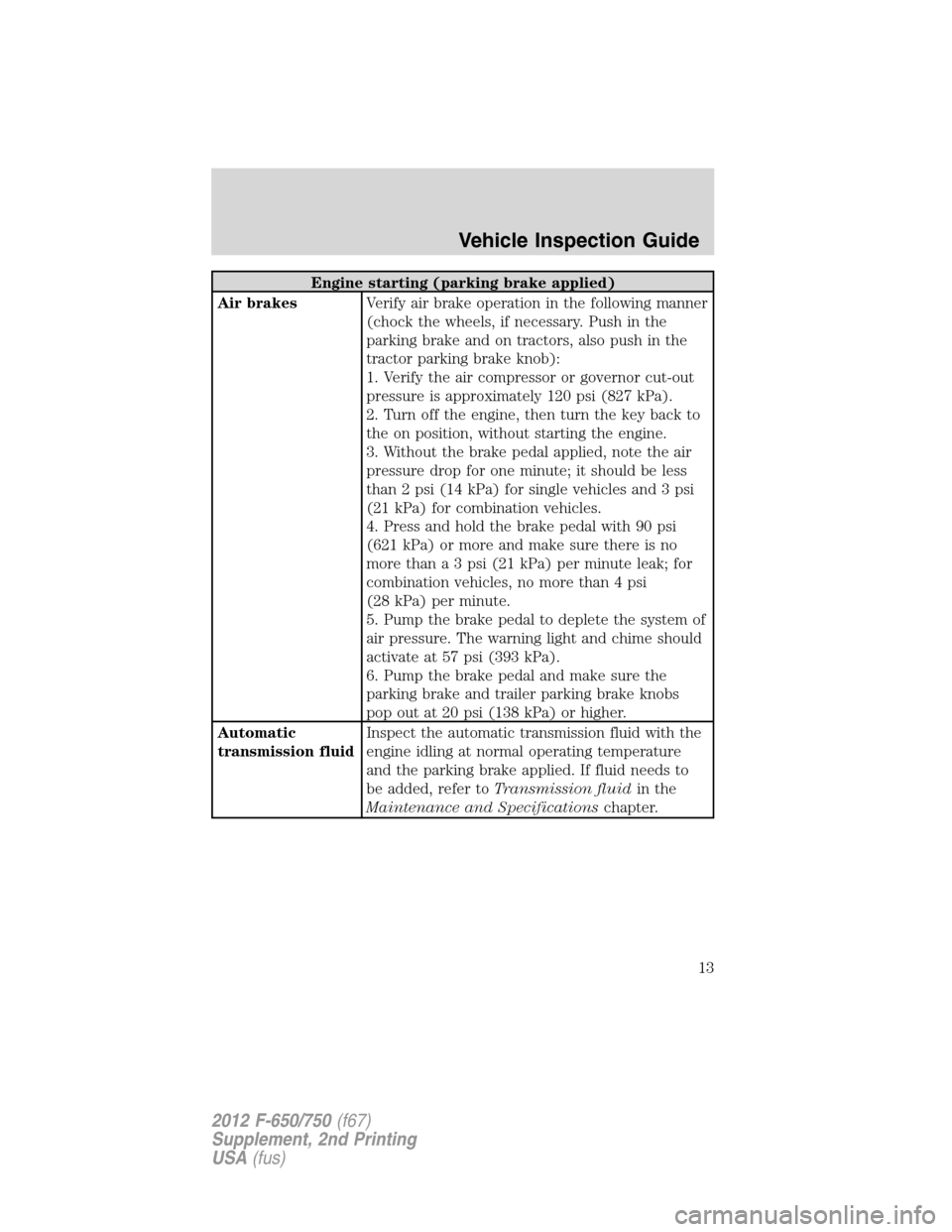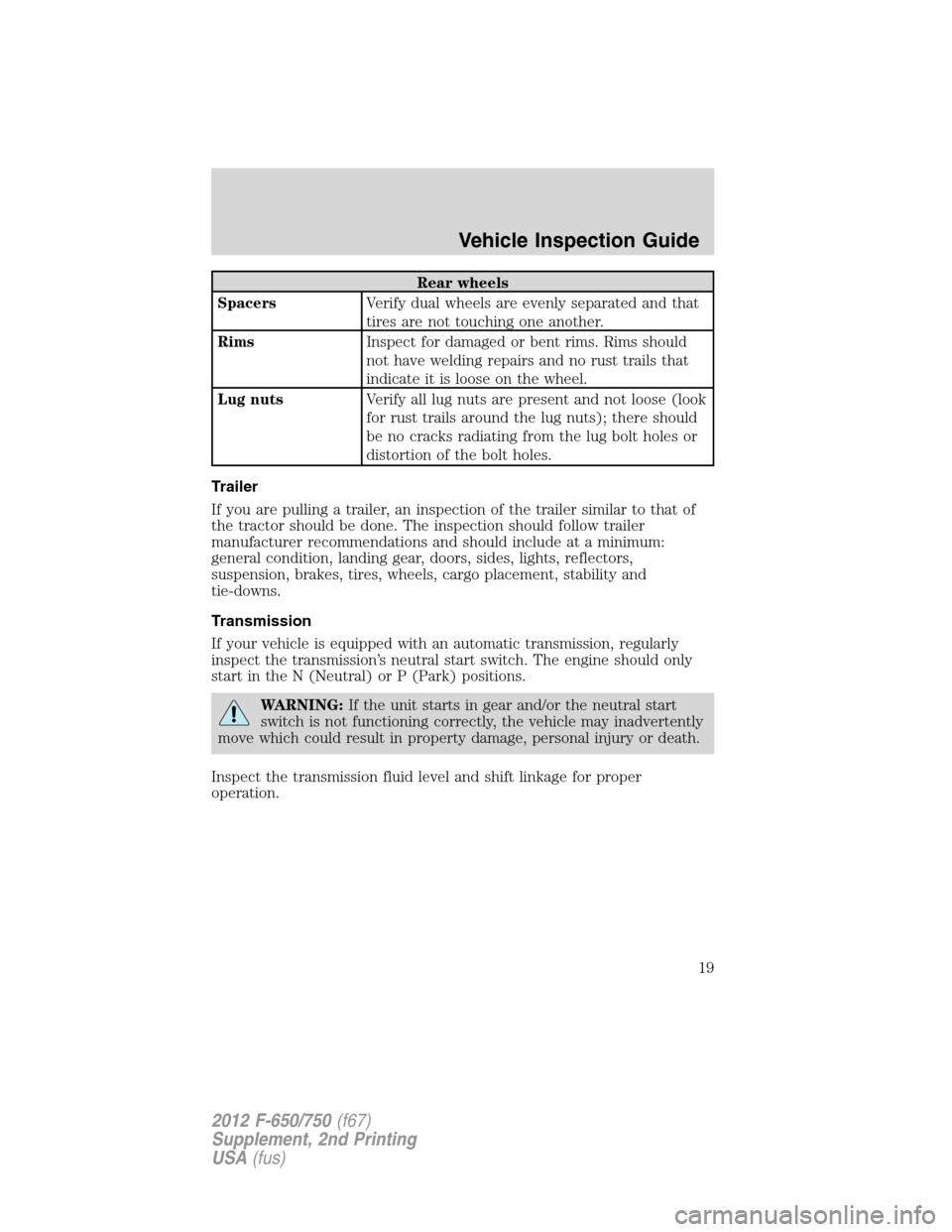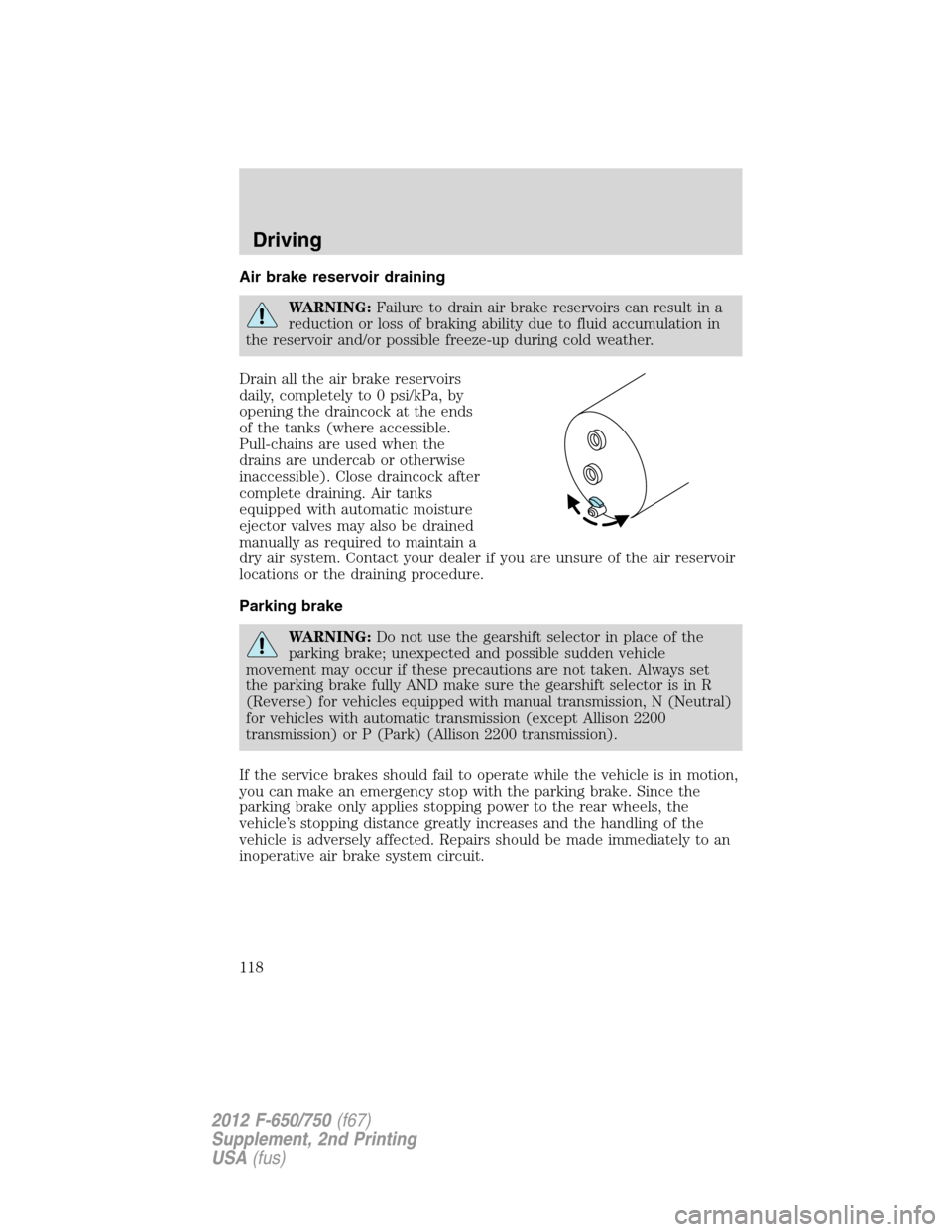2012 FORD F650 automatic transmission fluid
[x] Cancel search: automatic transmission fluidPage 13 of 306

Engine starting (parking brake applied)
Air brakesVerify air brake operation in the following manner
(chock the wheels, if necessary. Push in the
parking brake and on tractors, also push in the
tractor parking brake knob):
1. Verify the air compressor or governor cut-out
pressure is approximately 120 psi (827 kPa).
2. Turn off the engine, then turn the key back to
the on position, without starting the engine.
3. Without the brake pedal applied, note the air
pressure drop for one minute; it should be less
than 2 psi (14 kPa) for single vehicles and 3 psi
(21 kPa) for combination vehicles.
4. Press and hold the brake pedal with 90 psi
(621 kPa) or more and make sure there is no
more than a 3 psi (21 kPa) per minute leak; for
combination vehicles, no more than 4 psi
(28 kPa) per minute.
5. Pump the brake pedal to deplete the system of
air pressure. The warning light and chime should
activate at 57 psi (393 kPa).
6. Pump the brake pedal and make sure the
parking brake and trailer parking brake knobs
pop out at 20 psi (138 kPa) or higher.
Automatic
transmission fluidInspect the automatic transmission fluid with the
engine idling at normal operating temperature
and the parking brake applied. If fluid needs to
be added, refer toTransmission fluidin the
Maintenance and Specificationschapter.
Vehicle Inspection Guide
13
2012 F-650/750(f67)
Supplement, 2nd Printing
USA(fus)
Page 19 of 306

Rear wheels
SpacersVerify dual wheels are evenly separated and that
tires are not touching one another.
RimsInspect for damaged or bent rims. Rims should
not have welding repairs and no rust trails that
indicate it is loose on the wheel.
Lug nutsVerify all lug nuts are present and not loose (look
for rust trails around the lug nuts); there should
be no cracks radiating from the lug bolt holes or
distortion of the bolt holes.
Trailer
If you are pulling a trailer, an inspection of the trailer similar to that of
the tractor should be done. The inspection should follow trailer
manufacturer recommendations and should include at a minimum:
general condition, landing gear, doors, sides, lights, reflectors,
suspension, brakes, tires, wheels, cargo placement, stability and
tie-downs.
Transmission
If your vehicle is equipped with an automatic transmission, regularly
inspect the transmission’s neutral start switch. The engine should only
start in the N (Neutral) or P (Park) positions.
WARNING:If the unit starts in gear and/or the neutral start
switch is not functioning correctly, the vehicle may inadvertently
move which could result in property damage, personal injury or death.
Inspect the transmission fluid level and shift linkage for proper
operation.
Vehicle Inspection Guide
19
2012 F-650/750(f67)
Supplement, 2nd Printing
USA(fus)
Page 22 of 306

Charging system:Illuminates when
the battery is not charging properly.
If it stays on while the engine is
running, there may be a malfunction
with the charging system or a related component. Contact your
authorized dealer as soon as possible.
Check fuel cap (gasoline engine
only):Illuminates when the fuel cap
may not be properly installed.
Continued driving with this light on
may cause the service engine soon
warning indicator to illuminate.
Check suspension (if equipped):
Illuminates when the air suspension
dump switch has been activated.
Check trans (Allison automatic
transmission only):Illuminates
while driving if a problem has been
detected and shifting may be
restricted. Depending upon the
severity of the problem, the
read-out digit on the shifter display
may be blank.
On MD 3000 series transmissions,operation may continue in order to
reach service assistance. The ECU may not respond to shift selector
requests, since operating limitations are being placed on the
transmission, i.e. upshifts and downshifts may be restricted. Direction
changes do not occur.
Refer to your transmission operator’s manual for more information.
Diesel exhaust fluid (diesel
engine only):Illuminates when the
diesel exhaust fluid level falls below
0.5 gallon (1.9L) in the 5 gallon
(19.0L) tank or 1 gallon (3.8L) in
the 9 gallon (34.0L) tank. Refill the
tank or, at a minimum, add at least
1 gallon (3.8L) to the 5 gallon
(19.0L) tank or 2 gallons (7.6L) to the 9 gallon (34.0L) tank.
Instrument Cluster
22
2012 F-650/750(f67)
Supplement, 2nd Printing
USA(fus)
Page 118 of 306

Air brake reservoir draining
WARNING:Failure to drain air brake reservoirs can result in a
reduction or loss of braking ability due to fluid accumulation in
the reservoir and/or possible freeze-up during cold weather.
Drain all the air brake reservoirs
daily, completely to 0 psi/kPa, by
opening the draincock at the ends
of the tanks (where accessible.
Pull-chains are used when the
drains are undercab or otherwise
inaccessible). Close draincock after
complete draining. Air tanks
equipped with automatic moisture
ejector valves may also be drained
manually as required to maintain a
dry air system. Contact your dealer if you are unsure of the air reservoir
locations or the draining procedure.
Parking brake
WARNING:Do not use the gearshift selector in place of the
parking brake; unexpected and possible sudden vehicle
movement may occur if these precautions are not taken. Always set
the parking brake fully AND make sure the gearshift selector is in R
(Reverse) for vehicles equipped with manual transmission, N (Neutral)
for vehicles with automatic transmission (except Allison 2200
transmission) or P (Park) (Allison 2200 transmission).
If the service brakes should fail to operate while the vehicle is in motion,
you can make an emergency stop with the parking brake. Since the
parking brake only applies stopping power to the rear wheels, the
vehicle’s stopping distance greatly increases and the handling of the
vehicle is adversely affected. Repairs should be made immediately to an
inoperative air brake system circuit.
Driving
118
2012 F-650/750(f67)
Supplement, 2nd Printing
USA(fus)
Page 223 of 306

Exhaust System:
•Inspect for leaks at various joint connections and loose clamps.
•Perform a visual inspection for cracks or holes in the muffler and tail
pipe.
•Always use the recommended parts when items need to be replaced.
•Do not change the tail pipe elbow or offset tail pipe orientation from
the standard position as originally received.
•To avoid abnormal changes in vehicle sound levels, it is necessary for
the owner to perform inspections and necessary maintenance at the
intervals shown in theScheduled Maintenance Guidechapter.
POWER STEERING FLUID
Check the power steering fluid level using the following procedure:
1. Set the parking brake, shift into N (Neutral) (automatic transmission)
or 1 (First) (manual transmission) and turn the engine off.
2. Open the hood.
3. Clean the top of the power steering fluid reservoir.
4. Remove the dipstick from the reservoir and wipe the dipstick clean.
5. Reinstall the dipstick. Remove it again and check the fluid level.
•Check the COLD side of the
dipstick if the fluid is cool or
warm to the touch
(approximately 68°-120°F
[20°-49°C]); the fluid level should
be within the FULL range. If
necessary, add fluid in small
amounts, continuously checking
the level, until it reaches the proper level.
•Check the HOT side of the
dipstick if the fluid is too hot to
touch (approximately 176°–230°F
[80°-110°C]); the fluid level
should be within the FULL range.
If necessary, add fluid in small
amounts, continuously checking
the level, until it reaches the
proper level.
Whenever the dipstick is installed, make sure it is properly seated and
tightened securely.
ADD MAX. COLDFULL
ADD MAX. HOTFULL
Maintenance and Specifications
223
2012 F-650/750(f67)
Supplement, 2nd Printing
USA(fus)
Page 226 of 306

Transmission and clutch
removed for clarity
3. Lubricate the clutch release bearing (at one location) and the clutch
release shaft (at two locations), using the grease fittings provided, with a
grease gun.
4. Lubricate clutch release wear pads at the two locations where they
contact the clutch release bearing with a brush or similar tool.
5. Install the inspection cover onto the clutch housing.
Refer to theScheduled Maintenance Guidechapter for the service
interval schedules.
TRANSMISSION FLUID
Automatic transmission fluid
Refer to yourAllison Automatic Transmission Operator’s Manualfor
scheduled transmission fluid check/change intervals. Your transmission
does not consume fluid. However, the fluid level should be checked if the
transmission is not working properly, i.e., if the transmission slips or
shifts slowly or if you notice some sign of fluid leakage.
Automatic transmission fluid expands when warmed. To obtain an
accurate fluid check, drive the vehicle until it is warmed up
(approximately 20 miles [30 km]). If your vehicle has been operated for
an extended period at high speeds, in city traffic or during hot weather,
the vehicle should be turned off for about 30 minutes to allow fluid to
cool before checking.
1. Drive the vehicle 20 miles (30 km) or until it reaches normal operating
temperature.
2. Park the vehicle on a level surface and engage the parking brake.
3. With the parking brake engaged and your foot on the brake pedal,
start the engine and move the gearshift lever through all of the gear
ranges. Allow sufficient time for each gear to engage.
Maintenance and Specifications
226
2012 F-650/750(f67)
Supplement, 2nd Printing
USA(fus)
Page 227 of 306

4. Place the gearshift lever in N (Neutral) or P (Park) and leave the
engine running.
5. Remove the dipstick, wiping it clean with a clean, dry, lint-free rag.
6. Install the dipstick, making sure it is fully seated in the filler tube.
7. Remove the dipstick and inspect the fluid level.
If you must add transmission fluid, refer to yourAllison Automatic
Transmission Operator’s Manualfor the correct fluid type.Use of a
non-approved automatic transmission fluid may cause internal
transmission component damage.
Fluid levels above the safe range may result in transmission failure; an
overfill condition of transmission fluid may cause shift and/or
engagement concerns and/or possible damage.
Eaton UltraShift (if equipped)
The Eaton UltraShift transmission is filled with synthetic fluid from the
factory with no scheduled fluid change intervals as this fluid is intended
to last the life of the transmission. However, the system should be
checked regularly to ensure that proper transmission fluid levels remain
constant. Refer to theEaton Driver Instructions Manualfor details.
Manual transmission fluid
Refer to theScheduled Maintenance Guidechapter for transmission
fluid level check/change intervals.
Your manual transmission may be filled with an optional synthetic fluid
which allows the use of extended service intervals. A tag on the filler
plug identifies the use of the synthetic fluid.
Only use fluid that meets manufacturer specifications; refer toLubricant
specificationsin this chapter.Use of a non-approved transmission
fluid may cause internal transmission component damage.
Check your transmission fluid level using the following procedure:
1. Park the vehicle on level ground.
2. Set the parking brake and shift into 1 (First) and turn the engine off.
3. Clean any dirt from around the filler plug.
4. Remove the filler plug and inspect the fluid level; the fluid level should
be at the bottom of the filler plug opening.
5. Add fluid, if necessary, through the filler plug opening.
6. Clean and install the filler plug securely.
Maintenance and Specifications
227
2012 F-650/750(f67)
Supplement, 2nd Printing
USA(fus)
Page 232 of 306

Checking the rear axle lubricant level
1. Park the vehicle on level ground.
2. Set the parking brake and shift into N (Neutral) (automatic
transmission) or 1 (First) (manual transmission) and turn the engine off.
3. Clean any dirt from around the rear axle filler plug.
4. Remove the filler plug and inspect the lubricant level; it should be up
to the bottom of the filler plug opening.
5. Add lubricant, if necessary, through the filler plug opening.
6. Clean and install the filler plug securely.
Draining and refilling the rear axle lubricant
1. Drain the rear axle while the lubricant is warm.
2. Park the vehicle on level ground.
3. Set the parking brake and shift into N (Neutral) (automatic
transmission) or 1 (First) (manual transmission) and turn the engine off.
4. Clean any dirt from around the rear axle filler and drain plugs.
5. Remove the filler and drain plugs and drain the lubricant into a
suitable container. Dispose of all used automotive fluids in a responsible
manner following your local authorized standards.
6. Clean and install the drain plug securely.
7. Add lubricant through the filler plug opening.
8. Clean and install the filler plug securely.
WHEELS
General
Wheel bearings should be inspected, lubricated and adjusted at regular
intervals. This is especially important if operating in deep sand, mud or
water. Refer toLubricant specificationsin this chapter.
Mount wheel balance weights on the dome-side of the wheel only; failure
to do so may result in loss of wheel weight and/or damage to brakes or
wheels.
Important:Remember to replace the wheel air valves when the road
tires are replaced at the end of their useful life.
Maintenance and Specifications
232
2012 F-650/750(f67)
Supplement, 2nd Printing
USA(fus)